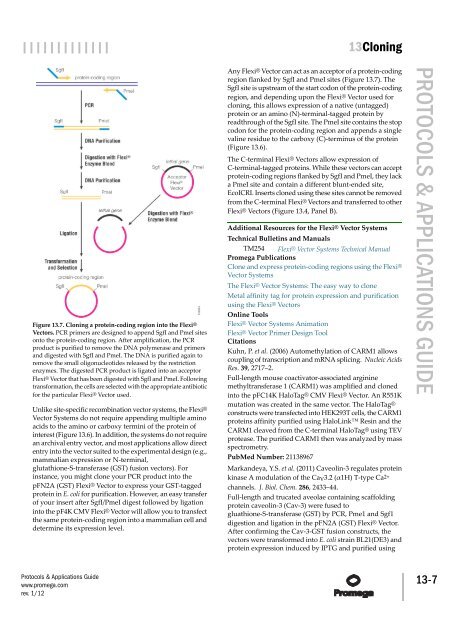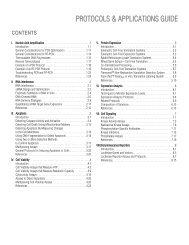Cloning Protocols and Applications Guide-A4 format - Promega
Cloning Protocols and Applications Guide-A4 format - Promega
Cloning Protocols and Applications Guide-A4 format - Promega
You also want an ePaper? Increase the reach of your titles
YUMPU automatically turns print PDFs into web optimized ePapers that Google loves.
||||||||||||| 13<strong>Cloning</strong><br />
Figure 13.7. <strong>Cloning</strong> a protein-coding region into the Flexi®<br />
Vectors. PCR primers are designed to append SgfI <strong>and</strong> PmeI sites<br />
onto the protein-coding region. After amplification, the PCR<br />
product is purified to remove the DNA polymerase <strong>and</strong> primers<br />
<strong>and</strong> digested with SgfI <strong>and</strong> PmeI. The DNA is purified again to<br />
remove the small oligonucleotides released by the restriction<br />
enzymes. The digested PCR product is ligated into an acceptor<br />
Flexi® Vector that has been digested with SgfI <strong>and</strong> PmeI. Following<br />
trans<strong>format</strong>ion, the cells are selected with the appropriate antibiotic<br />
for the particular Flexi® Vector used.<br />
Unlike site-specific recombination vector systems, the Flexi®<br />
Vector Systems do not require appending multiple amino<br />
acids to the amino or carboxy termini of the protein of<br />
interest (Figure 13.6). In addition, the systems do not require<br />
an archival entry vector, <strong>and</strong> most applications allow direct<br />
entry into the vector suited to the experimental design (e.g.,<br />
mammalian expression or N-terminal,<br />
glutathione-S-transferase (GST) fusion vectors). For<br />
instance, you might clone your PCR product into the<br />
pFN2A (GST) Flexi® Vector to express your GST-tagged<br />
protein in E. coli for purification. However, an easy transfer<br />
of your insert after SgfI/PmeI digest followed by ligation<br />
into the pF4K CMV Flexi® Vector will allow you to transfect<br />
the same protein-coding region into a mammalian cell <strong>and</strong><br />
determine its expression level.<br />
<strong>Protocols</strong> & <strong>Applications</strong> <strong>Guide</strong><br />
www.promega.com<br />
rev. 1/12<br />
Any Flexi® Vector can act as an acceptor of a protein-coding<br />
region flanked by SgfI <strong>and</strong> PmeI sites (Figure 13.7). The<br />
SgfI site is upstream of the start codon of the protein-coding<br />
region, <strong>and</strong> depending upon the Flexi® Vector used for<br />
cloning, this allows expression of a native (untagged)<br />
protein or an amino (N)-terminal-tagged protein by<br />
readthrough of the SgfI site. The PmeI site contains the stop<br />
codon for the protein-coding region <strong>and</strong> appends a single<br />
valine residue to the carboxy (C)-terminus of the protein<br />
(Figure 13.6).<br />
The C-terminal Flexi® Vectors allow expression of<br />
C-terminal-tagged proteins. While these vectors can accept<br />
protein-coding regions flanked by SgfI <strong>and</strong> PmeI, they lack<br />
a PmeI site <strong>and</strong> contain a different blunt-ended site,<br />
EcoICRI. Inserts cloned using these sites cannot be removed<br />
from the C-terminal Flexi® Vectors <strong>and</strong> transferred to other<br />
Flexi® Vectors (Figure 13.4, Panel B).<br />
Additional Resources for the Flexi® Vector Systems<br />
Technical Bulletins <strong>and</strong> Manuals<br />
TM254 Flexi® Vector Systems Technical Manual<br />
<strong>Promega</strong> Publications<br />
Clone <strong>and</strong> express protein-coding regions using the Flexi®<br />
Vector Systems<br />
The Flexi® Vector Systems: The easy way to clone<br />
Metal affinity tag for protein expression <strong>and</strong> purification<br />
using the Flexi® Vectors<br />
Online Tools<br />
Flexi® Vector Systems Animation<br />
Flexi® Vector Primer Design Tool<br />
Citations<br />
Kuhn, P. et al. (2006) Automethylation of CARM1 allows<br />
coupling of transcription <strong>and</strong> mRNA splicing. Nucleic Acids<br />
Res. 39, 2717–2.<br />
Full-length mouse coactivator-associated arginine<br />
methyltransferase 1 (CARM1) was amplified <strong>and</strong> cloned<br />
into the pFC14K HaloTag® CMV Flexi® Vector. An R551K<br />
mutation was created in the same vector. The HaloTag®<br />
constructs were transfected into HEK293T cells, the CARM1<br />
proteins affinity purified using HaloLink Resin <strong>and</strong> the<br />
CARM1 cleaved from the C-terminal HaloTag® using TEV<br />
protease. The purified CARM1 then was analyzed by mass<br />
spectrometry.<br />
PubMed Number: 21138967<br />
Mark<strong>and</strong>eya, Y.S. et al. (2011) Caveolin-3 regulates protein<br />
kinase A modulation of the CaV3.2 (α1H) T-type Ca2+<br />
channels. J. Biol. Chem. 286, 2433–44.<br />
Full-length <strong>and</strong> trucated aveolae containing scaffolding<br />
protein caveolin-3 (Cav-3) were fused to<br />
gluathione-S-transferase (GST) by PCR, Pme1 <strong>and</strong> Sgf1<br />
digestion <strong>and</strong> ligation in the pFN2A (GST) Flexi® Vector.<br />
After confirming the Cav-3-GST fusion constructs, the<br />
vectors were transformed into E. coli strain BL21(DE3) <strong>and</strong><br />
protein expression induced by IPTG <strong>and</strong> purified using<br />
PROTOCOLS & APPLICATIONS GUIDE 13-7

















